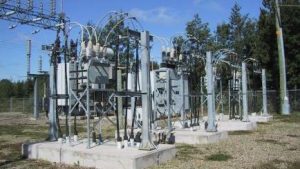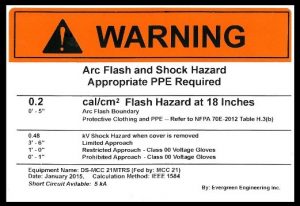What is an arc flash?
An arc flash happens when either phase-to-ground or phase-to-phase conductors arc in a short circuit, causing electrical equipment to explode. In a fraction of a second, temperatures can soar well beyond that of the sun’s surface. These extreme temperatures cause rapid heating of the surrounding air and create tremendous pressures, producing an arc-plasma fireball that can vaporize solid metal conductors instantly. These hazards can cause severe injury or death, as well as millions of dollars of damage in equipment and facility downtime.
Arc flash mitigation
 Evergreen Engineering staff has extensive experience in electrical safety, allowing us to thoroughly evaluate electrical systems and quickly deliver comprehensive solutions. We perform detailed arc flash analyses to provide correct equipment warning labels required by code, and provide strategies to minimize energy available in an arc flash event. This decreases your risk and ensures your facility meets codes and standards regulating arc flash including OSHA Standards 29 (CFR) Part 1910, NFPA Standard 70 and NFPA 70E (NCE), and IEEE.1584.
Evergreen Engineering staff has extensive experience in electrical safety, allowing us to thoroughly evaluate electrical systems and quickly deliver comprehensive solutions. We perform detailed arc flash analyses to provide correct equipment warning labels required by code, and provide strategies to minimize energy available in an arc flash event. This decreases your risk and ensures your facility meets codes and standards regulating arc flash including OSHA Standards 29 (CFR) Part 1910, NFPA Standard 70 and NFPA 70E (NCE), and IEEE.1584.
Arc flash analysis services
- Gathering field data of electrical equipment and documentation — where necessary, we can upgrade your single-line diagrams to reflect the latest conditions of the power distribution system.
- Analyzing field data and evaluating the arc flash hazards using specialized software like ESA or EDSA — for each transformer, switchboard, motor control center, or panel board, relevant arc flash data is calculated. Arc fault magnitude, arc flash boundaries, incident energy and the category of personal protection equipment (PPE) required at each location is provided.
- Providing a comprehensive Power Study that calculates the magnitude of fault currents, voltage drops and coordination of overcurrent protection devices, in addition to identifying arc flash hazards.
- Providing warning labels indicative of hazard levels and Personal Protection Equipment (PPE) required at all equipment locations.
- Recommending mitigation of hazard intensities; replacing fuses, adjusting trip settings of circuit breakers and relays, and other modifications of the power distribution equipment.
- Cost estimates for implementing the recommendations listed above.
- Electrical safety training.

